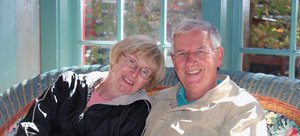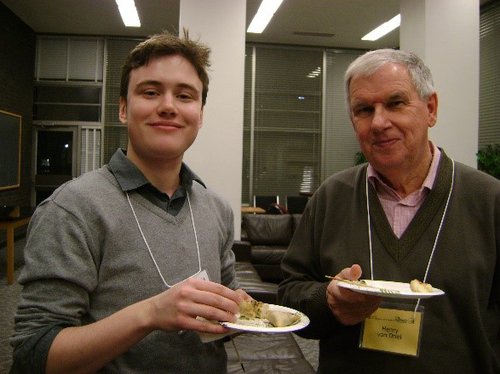Welcome to our first Emeritus Profile where we ask one of our emeritus faculty questions about their careers and what they have being doing since retirement.
Is there a faculty member that you recall from being a student and are you wondering what they are up to?
Do you have fond memories of a certain instructor?
Tell us who they are and we will try and connect with them for an update.

Thank you Professor van Driel for speaking to Interactions. How many years were you a faculty member at the Department of Physics?
Before I answer that let me thank you for inviting me to participate. My thoughts often turn to the department, especially during this pandemic, and I feel for students, staff and faculty who are faced with numerous personal and professional challenges.
Now to answer your question, I joined the faculty of U of T in 1976 through Erindale College (now UTM) where I taught and conducted research until 1988. I then transferred to the Physics Department on the St. George campus, retiring in 2014.
Can you tell us about your educational background from your undergraduate degree to your PhD?
I was fortunate to be admitted to U of T’s 4-year honours Mathematics, Physics and Chemistry (MPC) undergraduate program in 1966 and had my first year physics classes in the old physics building, now part of Sanford Fleming. After first year I focused on mathematics and physics with my physics classes now in the “new” building. I fondly recall many inspiring teachers such as Derek York, Rashmi Desai, Jan Van Kranendonk and Harry Welsh. Before Christine and I married in 1970 we knew we wanted to remain in Southern Ontario and I applied to and was accepted in the physics graduate program here at U of T. Robin Armstrong recruited me to be a MSc graduate student and I was happy to remain for my PhD.
What was the focus of your PhD and how did you choose it?
I was particularly interested in condensed matter physics because of its fundamental and applied nature. Robin got me interested in using nuclear quadrupole resonance (NQR) techniques to probe lattice dynamics and phase transitions in antifluorite and perovskite crystals. He gave me considerable independence and I became involved in all aspects of my project including growing samples, constructing and using a pulsed radio frequency spectrometer and developing theoretical formalism for interpreting data. After finishing my PhD thesis in late 1974, I took an NRC postdoctoral fellowship to the Optical Sciences Centre at the University of Arizona and began work in ultrafast optical spectroscopy of semiconductors, with carrier frequency and pulse widths differing from ones used in my PhD by 6 orders of magnitude.
What kind of physics did you teach? And why?
At Erindale College in the 70s and 80s there were only 6 physics faculty and, like my colleagues, I taught nearly every course once, from first year physics to advanced classical and quantum mechanics. Upon transfer to the St. George campus I mainly taught first year physics to Physics Specialists or Engineering Science students. In the first-year courses I basked in the incredible energy and enthusiasm of highly motivated students. I particularly enjoyed doing demonstrations. Whether they “worked" or not, and perhaps more so if they didn’t, the students and I had a lot of fun.
When I was chair of the department for four years I taught a first-year seminar course for about 20 Humanities students on the Riddle of Light, first taught by Boris Stoicheff. We discussed light in art, religion, theatre, medicine, etc. and I brought in external experts from time to time as guest lecturers. Although the course was quite enjoyable , the dynamics and questions were very different from those in other first year courses I had taught since mathematics was verboten. During the 10-minute break of a two hour lecture I served juice and cookies (paralleling what is done before or after research seminars) and learned a lot about the students’ ambitions.
I also taught modern optics to 3rd and 4th year students and laser physics or nonlinear optics to graduate students. These courses were more directly related to my research, and because the classes were much smaller than the large first year ones, it was possible to get to know all the students as I did in the seminar course.
What are your fondest memories of being a faculty member in the U of T Physics Department?
There are so many. I’ve already discussed all the rewards of teaching. On the research side, my fondest memories are of working with highly motivated, bright graduate students and postdocs. I was proud to graduate 30 PhD students and it’s great to see that so many have obtained prominent positions in academia, industry and government labs. I miss our weekly group lunches and meetings where we would all take turns chairing the meeting and taking notes. Over the years, we also had several stimulating interactions with John Sipe and his group as well as visitors from Israel, Germany, Russia, the US and the Czech Republic. On the administration side, when I was chair of the department I enjoyed helping to recruit 15 new faculty members and launch their careers which I continue to follow with great interest.
What have you been doing during your retirement?
Before the onset of the pandemic I mainly divided my time between personal and professional volunteering activities. With our 6 grandchildren Christine and I went golfing, hiking, biking, swimming and canoeing in the summer and skiing, skating, bowling, etc. in the winter. Christine and I would also have them stay over for a few days at our house, one at a time, two at a time, or four at a time, which 5-year-old Claire refers to respectively as private, semi-private and public vacations...but a vacation for whom? From time to time I would golf with Robin but that was always quite competitive. I also served my church on several committees overseeing such matters as maintenance and finance. Professionally, as an Associate Editor I helped to launch the new Optical Society of America journal, Optica, and also served on research review panels in Canada, the USA, and Ireland. During the pandemic some of my activities have been altered, although on the professional front I had already begun to wean myself of grant and manuscript reviews since I no longer feel I have the expertise to assess forefront research.
You have been a mentor to 3rd and 4th students in the Physics Mentorship Program for over five years. Why do you mentor students? And why do you think mentoring is important?
I’ve enjoyed mentoring graduate students, summer research students and undergraduates for nearly 50 years. I agreed to help with the Physics Mentorship Program after I retired in order to maintain contact with young scholars. I benefited enormously from the great mentors I had as an undergraduate so I hoped to bring similar insights to students today. Besides having been a professor and researcher I have also done consulting work with large and small companies so I felt I could offer perceptions into how careers in areas outside of academia might begin and evolve.
Each student is different and we tailor our interactions accordingly. Some students have well-defined plans and only ask specific questions about, e.g., graduate school. However, one of my mentees was quite open-minded and came with a page full of questions every time we met. At the first meeting the questions were about what it’s like to work in academia. Another time they were about work at a small company. At the 3rd meeting it was about what it might be like to start a company. This went on for 6 meetings, after which I felt like we had exhausted all possibilities apart perhaps from a career in Hollywood! Another mentee was torn between a career in music and going to graduate school. It was easy to sense that his real love was music (and indeed he already had part time employment) and I simply advised him to follow his passion. However, years earlier I also had a very productive summer undergraduate researcher who faced the same dilemma. I gave him the same advice and now I break into a smile whenever I hear him on the radio.
(The photo below is mentee Alex Cabaj and Henry van Driel at a Mentorship event)

Anything else you would like us to know or share?
One often hears that retirement is about attaining freedom but for a faculty member that’s rarely a consideration, especially after the end of mandatory retirement in 2004. Indeed, ever since I was a child I’ve never really thought about freedom. Parents today would be shocked at the amount of independence my parents gave me when I was growing up in Invermere, a small town in British Columbia, with no TV reception and where I had to be creative in finding adventures or projects to pursue as I tried to cheat the second law of thermodynamics. Looking back, I was lucky to survive childhood but all the experiences helped develop imagination and resourcefulness. I was fortunate too when Robin Armstrong allowed me to define my own PhD. program. And as a faculty member, as my colleagues know, the university administration makes little demands on you and you can choose which courses to teach, what research to do and with whom, how much administration to help with, etc. And now in retirement, even as Christine and I navigate through the pandemic, there are still all my outdoor activities to pursue, plenty of books to read, projects to finish in my workshop, and new people to engage, even if most of them cringe when I reveal my background in physics.

